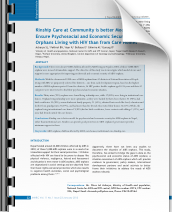There were about 24,000 children affected by AIDS living in Nepal in 2010; of these 5,000 AIDS orphans were in need of immediate support. The objective of this study was to investigate which model of care and support is more appropriate for improving psychosocial and economic security of AIDS orphans. With 5200 documented cases of AIDS orphans from 42 districts at National Association of People Living with HIV, the authors purposively selected five districts – one from each development region, based on the highest number of AIDS orphans reported. From five districts, 56 HIV positive double orphans aged 8-18 years and their 42 caregivers were interviewed to assess their psychosocial and economic situation. Thirty nine (70%) orphans were found living in kinship care, while 17 (30%) were living in institutional care homes. The majority of children in kinship care were living with grand parents (56%), brothers/sisters (8%) and uncle/aunts (5%).
The study found that children affected by AIDS living in kinship care were psychosocially and economically more secure than children living in care homes. Orphans living in kinship were more optimistic, as they were backed by their close relatives 35 (90%), had birth certificates 35 (90%), ensured inherent family property 21 (54%), obtained basic needs like food, education and shelter from grandparents 23 (59%), and had more than five friends who visited their homes 26 (67%). While, the orphans living in institutional care homes 17 (30%) had no birth certificates, fewer contacts with siblings 2 (12%), and none had friends outside the care homes.
The authors conclude by recommending that kinship care should be promoted rather than institutional care in Nepal, to ensure better social security for children affected by AIDS. The government should come up with financial and technical aid for the care givers of these children to ensure their quality of lives and fundamental rights. They also recommend that all stakeholders should integrate kinship care in their programs for better care and support of these children so that they can lead economically and socially productive life.
The abstract of this paper is available for free by clicking on the link above. To access the full publication, contact us or use your institutional access.
©Journal of Nepal Health Research Council 2013 Jan; 11(23): 22-5

